At the very minimum, your boots need to be sturdy. Beyond that, you’ll want to look at some specific characteristics depending on how (and what) you ride.
STREETBIKE RIDERS You have a pretty wide range of options, but leather construction is a must, as is over-the-ankle protection. Stay away from laces (they can get caught in your bike's mechanicals); zip-up boots are faster to get on and off, and are often more waterproof. Firm synthetic soles grip pavement well during stops, and let you push down on the footpegs with less discomfort. Heels should be wide and low, but with enough height to hook over the footpegs. The toe needs to fit under the shift lever comfortably. A shifter patch isn't a necessity, but adds to boot life where the shift lever rubs the top of the left shoe. Traditional black shows dirt less and shrugs off shifter scuffs.
DIRTBIKE RIDERS Look for specialized boots with plenty of plastic armor and epic ankle support. Steel or reinforced shanks are a must. A smoother sole lets you put your foot down in corners during flattrack-style slides. Stout shin protection defends against sticks and rocks. Ski-boot-style buckles (usually four) let you adjust fit quickly. Special grip panels on the left boot match the shift lever. An elastic top gasket keeps debris out. A separate inner bootie provides better fit and comfort.
ADVENTURE-BIKE RIDERS You'll want many of the same features as a dirt boot, but shorter and lighter; you need a boot that's more comfortable to walk in, too—get one with a sole that's more flexible and that offers more traction. It should be weatherproof as well—look for a Gore-Tex lined model.
ROADRACERS Specialized footwear takes you through severe lean angles—good race boots will offer replaceable plastic sliders on the outside of the boot toes.
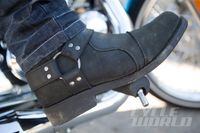
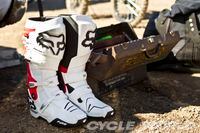
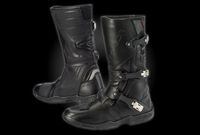
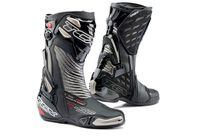
/cloudfront-us-east-1.images.arcpublishing.com/octane/OIKJC4JA3ZH7BMKUGWYKBIY5FA.jpg)
/cloudfront-us-east-1.images.arcpublishing.com/octane/MT2SAEWY6FDXFBYSLDE3AEFDTM.jpg)
/cloudfront-us-east-1.images.arcpublishing.com/octane/66UPKPYVURBPRCP5HXSN56MEMM.jpg)
/cloudfront-us-east-1.images.arcpublishing.com/octane/EOREGDSRKFDCRJC6K3EDVHBGCE.jpg)
/cloudfront-us-east-1.images.arcpublishing.com/octane/42RF63Q3LVCMBP3DGTWXFYSMOA.jpg)
/cloudfront-us-east-1.images.arcpublishing.com/octane/XNVY3EVWZFCEVPUGJGAN633LXE.jpg)
/cloudfront-us-east-1.images.arcpublishing.com/octane/2PLTVHXY7FDSPFHKU5CFOC43ZY.jpg)
/cloudfront-us-east-1.images.arcpublishing.com/octane/B6M3WTRLFZGNXBEATNXPVGBBD4.jpg)
/cloudfront-us-east-1.images.arcpublishing.com/octane/4CMH3FI73BEM5D6MFYX42FLDSQ.jpg)
/cloudfront-us-east-1.images.arcpublishing.com/octane/RIHAPYNWU5H3XAOXNOPRWCBTQA.jpg)
/cloudfront-us-east-1.images.arcpublishing.com/octane/HU4NUBCL3VAFZA75VYRCMAUHVM.jpg)
/cloudfront-us-east-1.images.arcpublishing.com/octane/OB43AZK7TRA6XLZL5WRDVW2TDA.jpg)
/cloudfront-us-east-1.images.arcpublishing.com/octane/5G44Y3FXWNFSTEQKCA355PXOPU.jpg)

/cloudfront-us-east-1.images.arcpublishing.com/octane/XRI4GTLCVBA5NESASCBIR5LYQI.jpg)
/cloudfront-us-east-1.images.arcpublishing.com/octane/EF7566PXARGMBAOMLWTECYL3LE.jpg)



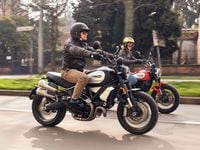

/cloudfront-us-east-1.images.arcpublishing.com/octane/3LASNXSWUZFFPISURDJF3OCWBU.jpg)
/cloudfront-us-east-1.images.arcpublishing.com/octane/2BHJKWUTBNBTLMQCKDNVEG6DKQ.jpg)
/cloudfront-us-east-1.images.arcpublishing.com/octane/MPHXIIV54NAU5L6E4SYZHCXVRM.jpg)